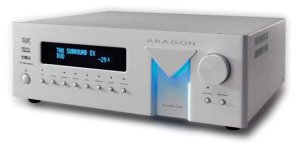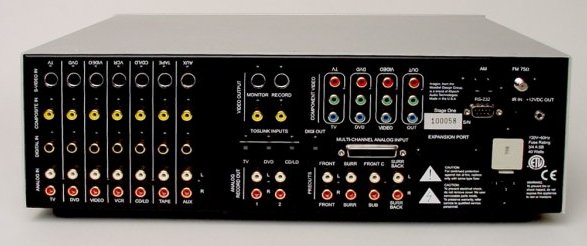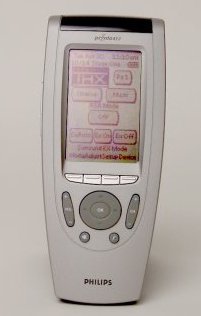|
|
 |
|
Specifications:●
Eight-Channel THX Ultra2 Preamplifier/Processor
● MFR: 10 Hz - 100 kHz - 3 dB
● S/N: 100 dB
● THD: < 0.02%
● Inputs: Seven Analog, Seven Coax Digital, Three Toslink, Seven
Composite, Seven S-Video, Three Component Video
● Outputs: Eight RCA Analog Coax, One
Toslink, Two S-Video, One Component Video
● Size: 5.8" H x 17" W x 15.25" D
● Weight: 27 Pounds
● MSRP: $4,000 USA
Aragon:
www.klipsch.com
|
|
Introduction
For those
not familiar with Aragon, the company is anything but new blood. They are a
branch of Mondial Designs who have had a foothold in the industry for
roughly sixteen years now. In 2001, they were acquired by Klipsch as an
elite line of A/V products. This is a move similar to what Anthem has done
recently with Paradigm. It allows bigger financial backing as well as
broader word of mouth.
Despite
the fact that you can find Klipsch equipment in many electronic retailers,
you may not find Aragon products. Aragon has committed to being very
selective about its distribution to separate itself from the misconception
of their equipment being common fare.
If Looks Could Kill
Without a doubt this is one of the most striking products available. Aragon
has put touches on its processor that sets it apart from other components
and just breathes high end in form and function. Some say that looks are not
important, but note there are probably more people who buy products based on
their name or appearance than anything else. Not to say that this piece
isn't as good from a technical standpoint as it is from a beauty standpoint.
The front
faceplate is a delight to the eyes, from the subtle blue LED display to the
adjustable blue lighting that cascades down the right hand portion of the
panel. The piece oozes elegance and proves that just a little bit of style
can make a huge difference. When I recently attended the CEDIA trade show I
wandered over to Aragon's display and was greeted by many oohs and ahhhs
from the gallery as they looked at the pieces. Shown below are the Stage One
sitting on top of a matching multi-channel power amplifier (Aragon 2007).

The front
panel controls are minimal and straightforward in operation. Too may times I
have a piece of equipment that is flooded with knobs and buttons which
intimidate potential users. Not the case here. Underneath the LED display
are simple buttons to select the desired input. Just to the right is a Mute
button and an "Enter" switch for the setup. All that is left is the volume
control which also serves as a selection device for the setup menus. Aragon
has opted to not include an onscreen display for reasons I'll discuss later
in the review.
If the front plate is a work of beauty, then the back panel is a work of
simplicity. On the left side of the panel are the main inputs in a layout
reminiscent of a modular card based unit. There are seven main inputs, each
labeled individually and pre-programmed. For each input there is an S-Video
and composite video connection. For audio there is a coaxial digital
connection and a two-channel analog input.
When
connected the processor automatically senses which input is being used, so
there is no programming or assigning for basic inputs. There are three
component video inputs that are pre-assigned to certain sources, and the
processor will automatically sense the video source and use it. The same
applies for the three Toslink digital inputs that are pre-assigned to
certain inputs. I was happy to see Aragon include so many coaxial digital
inputs, as these seem to be lacking on other processors.

Last up is
the seven-channel analog input. This is a straight pass through connection
that is only affected by the volume control and op amps before being passed
to the amplifier.
Those
looking for DSP processing or bass management won't have any luck here.
Aragon is a company that bases its decision on having the best audio
processing and wanted the purity of the analog signal intact. For connection
to a SACD/DVD-A multi-channel analog out, there is a DB-25 jack instead of
the typical RCA jacks. This requires the purchase of a special cable that I
was only able to find from Monster Cable to use a DVD-A or SACD player. This
was done because of space issues on the back panel.
Although the current Stage One does not have balanced inputs or outputs,
Aragon has mentioned that they may offer a balanced version of the Stage One
at a later time similar to what Lexicon did with the MC-12. This will be a
slightly larger chassis with the connections on the bottom.
It's what's on the inside that counts.
To really get a sense of how Aragon went about creating this product, you
have to go to the heart of the processor. This involves taking a few screws
out and looking at the inside of course, a move not recommended to the
owners. So, since you probably won't, I will. The Stage One has a very
robust power section with one isolated transformer serving as the power
supply. Some purists will scoff at the fact that Aragon has used one power
supply for both the digital and analog section of this piece, but I didn't
notice any performance hits as a result. The transformer is isolated in the
chassis away from the main boards and I don't see interference likely. In
fact, most of the boards are separated quite well. On the connection side,
all of the different types of connectors have their own boards which are
separated from the rest. This alleviates any crosstalk that may happen in
the audio and video paths.
At the bottom of the chassis is the main board which links the output stages
to the digital audio engine. Let's start with the audio engine itself. The
centerpiece is the new Motorola 56367 “Symphony” DSP chip. This new chip is
capable of processing 150 million instructions per second and is the heart
of the digital sound decoding for the processing. It is coupled with three
outboard ROMs that contain some of the DSP information. This is very similar
to the Anthem AVM-20 we reviewed last year. Although this is a very powerful
DSP, it still has its limitations. It can decode all of the latest Dolby
Digital and DTS surround sound formats with the exception of DTS 96/24. It
also handles the new THX Ultra2 processing.
You find the digital to analog converters (DACs) on the main audio engine
board. There are four Crystal Semi-Conductor (CS) 43122 stereo DACs to
handle the eight channels of output. These are 24 bit 192 kHz DACs. They
offer top of the line performance with 122 db dynamic range.
All of the volume control for the Stage One is kept in the analog realm, but
is digitally controlled. Utilizing four CS 3310 stereo digital volume
control chips, the signal from the front panel knob is processed on all
eight channels. This solution enables volume steps of 0.5db and zero
crosstalk between channels. It also allows the user enough flexibility to
pre-assign volume levels for each input as well as an overall maximum level
so the kids can't walk up and blow your speakers to kingdom come.
The Stage One employs outstanding operational amps, Texas Instruments
(formerly Burr Brown) 2134s. There are four included, one for each stereo
pair. These op-amps are renowned for their sonic character and are found on
some other very well regarded processors, including our pick for SSP of the
year for 2002, the Anthem AVM-20.
Tweaker's Delight
It truly seems that simplicity in design and function is the key to this
product. Users will find that there is nothing at all intimidating about the
Stage One. If you have even a little bit of savvy when it comes to setup, I
doubt you will ever need to consult the user's manual.
I mentioned earlier that the Stage One offers no onscreen display for setup.
I was skeptical of this at first, since onscreen menus are so easy to use
and can make a big difference for novice users. Aragon informed me that they
didn't want to do onscreen menus since they figured most of the users would
be using a high definition display and they could not facilitate progressive
scan menus. This makes sense in most cases, but I still would have like to
have seen some sort of OSD. But that doesn't mean that the setup provided is
hard. In fact this is one of the easiest setups I've seen yet.
By either accessing the menus on the remote or front panel, the user can use
the front display to dial in any settings needed. You start out in the main
setup menu, which includes speaker configurations, level settings, speaker
distances, THX setup, and crossover settings.
For speaker configuration you can choose either full range or small (THX).
By selecting "Small" you have the option of picking a crossover point from
the crossover settings menu. The processor offers a crossover of 25 Hz to
125 Hz in 5 Hz increments, and the setting applies universally to any
speaker set to small.
For speaker distances you can adjust the distance to any speaker, with the
exception of the subwoofer, in one inch increments up to 21'3”. Having the
ability to dial in a speaker in one inch measurements is an outstanding
feature that I have rarely seen. I really wish more companies would offer
this much flexibility. I am not sure why Aragon has foregone delay settings
for the sub channel. Although wavelengths for low bass can be extremely long
thus omni-directional, we at Secrets believe that all channels benefit from
proper delay settings.
For THX setup, there are a few different options. Since this is an Ultra2
product, there are options for the advanced stereo array (ASA) modes. First,
you must tell the processor the distance between the two rear speakers if
you opt to use two. Next, you must tell it whether you want to use the music
or movie mode for post processing. Last up is the ability to turn Re-eq on
or off when THX processing is engaged.
After this setup is complete, you can then enter the advanced setup menu.
There are a few extra options available here. For example, you can pre-set
speaker sizes to different surround modes. That way, if you want to run your
speakers in full range for stereo playback and in small for surround modes,
you can. You can also set your speaker levels separately for each DSP or
surround mode. I found this feature convenient on the Denon 5803, and I was
grateful to see it here as well. The controls for the front panel light and
reset controls are also found here. One thing of note though: Although the
processor allows you to turn off the cascading front panel light, it doesn't
allow you to dim or turn off the front display. I use a front projection
viewing system, and light control in my room is extremely important. This is
a feature I would have liked to have seen included, since by the omission of
an OSD you have to have the processor visible for setup and the light
emitted from the display can be annoying during movie playback.
Overall I found the controls for setup very easy and geared toward the
novice, but with enough flexibility to satisfy the hardcore enthusiast.
For processing, the Stage One offers just about everything there is to
offer. This includes the full Dolby compliment from Pro Logic II music and
movie modes, to Dolby Digital EX processing. They also have their DTS bases
covered with movie and music modes as well as ES discrete and matrix
processing. The DTS music mode does have the 10d b compensation for DTS
music CDs and DVDs as it should, as well as the 4 db offset for DTS movie
tracks.
For THX post processing, there is standard THX, THX Ultra2 music and movie
modes, as well as THX Surround EX. Aragon has also included a direct stereo
mode that acts as a bypass of the signal foregoing bass management and all
other digital processing. The Stage One is upgradeable using a RS-232
connection on the back or through hardware upgrades from Aragon.
Another item missing that I would have liked to have seen is an overall
audio delay for those using digital projectors. This enables the viewer to
adjust for minor delays caused by outboard video processors in front
projection systems. While this may be a trivial feature for some, it is
sorely missed by others.
One of the best features of this processor has to be its remote control. Too
many times have I seen companies try to come up with their own design only
to fail miserably compared to the offerings of universal remote companies.
Aragon didn't make this mistake and opted to use the very nice Pronto NEO
remote. It comes pre-programmed for the Stage One and can easily be
incorporated for the rest of your equipment just as any Pronto before it.
The NEO uses a LCD touch screen for most of its interfacing but does have
some nice tactile buttons for volume, mute, and menus. The remote control
often becomes a huge issue with time, and if the user interface isn't easy
and convenient, than it begins to wear on you.
Sounds About Right
Aragon was
an excellent product for me to make my first leap into the world of
separates, as it showed me exactly how good that leap can be. Aragon remains
true to its heritage and provides a compelling performance that just can't
be duplicated by a receiver. I used Aragon's 2007 THX Ultra2 seven-channel
amplifier for power and that is exactly what I got. Immediately I noticed
how much more open my soundstage became. The front part of the room was
drastically widened and the imaging was much more transparent. The depth and
detail from all areas were drastically increased and affirmed that I will
never go back to a receiver again. It didn't matter what format I used, be
it DVD playback or two-channel listening, the Aragon performed brilliantly.
The midrange was full and robust, and the low end had more detail and a
fuller tighter presence than I ever had from a receiver. I did think the
high end sounded a tad bright and revealing which some people prefer.
The preamp section of this processor is definitely the highlight. I have yet
to hear a digital processor that doesn't do nicely with movie soundtracks,
but there are a lot of them lacking in the preamp section. For two-channel
listening, I utilized the Krell DVD Standard as my transport and D to A
conversion. Although the DACs in the Stage One are excellent, I have yet to
hear anything that matches the Krell. But consider that the DVD Standard
costs twice the price of this processor. The Aragon was an extremely
transparent piece and didn't clutter the sound at all. This was very
apparent in cymbals. Too many times have I heard what I know to be a very
detailed transport get masked by a so called pass through.
While watching films, I noticed that my speakers really seemed to disappear
in the room, and the presence of the soundtrack was amazing. Using dynamic
soundtracks such as SW-Episode 1 was like hearing the track again for the
first time. There just seemed to be more layers to the sound that I wasn't
hearing before from the other equipment I was using.
DVD audio
also sounded great. Using Denon's DVD 9000 to take advantage of its digital
bass management, I listen to recordings from AIX and Chesky as well as the
current Warner titles. The AIX releases are amazing recordings that really
show off how good DVD-A can be. Even if I don't like the genre of music
playing, I am always blown away by the quality of the recording and the
precision used in the surround mixing. The Aragon equipment did a delightful
job with everything I threw at it. It revealed every sonic nuance and had a
rich natural tone that was a delight to the ears.
Conclusions
The Aragon Stage One is a very capable surround sound processor. Its
performance was very commendable and I didn't feel it slouched in any area.
I would have liked to have seen an OSD despite the fact that the front panel
interface is very easy to use. I would have also liked to have seen a set of
RCA inputs for the eight-channel input. These are small gripes that will
have to be weighed by the consumer of course. It does have some stiff
competition from companies like B&K and Anthem who are really pushing the
envelope as far as features go in this price range. I didn't have the chance
to compare the Aragon sonically to these products but I would have enjoyed
the opportunity to do so. All in all I think the Stage One is a compelling
piece sonically and keeps with the tradition of outstanding musicality
Mondial has been known for.
- Kris Deering -
Terms and Conditions of Use

|







